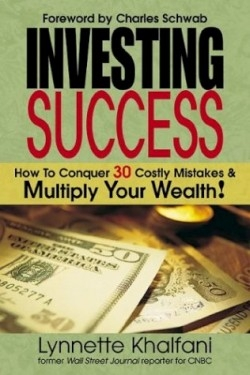Investing Success
How to Conquer 30 Costly Mistakes & Multiply Your Wealth!
“The amazing bull market of the late 1990s created a euphoria that was hard to resist,” notes brokerage house executive Charles R. Schwab in the introduction to this book. Then, in the three years from 2000 to 2002, huge stock market losses became commonplace. Could some of those losses been caused or exacerbated by investor blunders? The author thinks so, and identifies thirty common wrong moves that individual investors make.
Khalfani posits that the most successful investors “are simply the people who make the fewest investing mistakes.” She maintains that avoiding investing errors, and quickly changing course when they are made, leads to a consistent pattern of profitable results.
The author has witnessed all of these mistakes in the course of her career, and is candid about discussing missteps she herself has taken. A syndicated financial columnist who makes frequent television appearances on the Today show, she enumerates and discusses a single error in each chapter. They range from the strategic, such as failing to set specific, measurable, and realistic goals; to day-to-day errors, such as chasing the latest hot performers; to problems of mindset and attitude, such as firing a financial planner or broker without good cause.
At each chapter’s end, Khalfani provides a succinct “Summary success strategy” to avoid or overcome the mistake discussed. For the chapter dealing with the common error of over-concentration of wealth, she writes: “Put no more than 10% of your money into any one stock, bond, or fund. Avoid ‘concentrated’ wealth, where too much of your money is tied to one investment.” After another chapter, the author counsels, “Rebalance your portfolio as needed. Your asset allocation can get out of whack if certain investments start to represent a larger portion of your overall portfolio than you intended.”
The author employs her network of resources to advantage, and offers numerous quotes from financial experts including consultants, brokers, and other financial writers. Khalfani’s gift of rendering difficult investing concepts in clear, easily comprehensible prose-and her ability to use current events to illustrate her points-make the book useful for newer investors. It is no less helpful for long-time investors, who are likely to have experienced some of the author’s catalog of mistakes first-hand. (January).
Disclosure: This article is not an endorsement, but a review. The publisher of this book provided free copies of the book to have their book reviewed by a professional reviewer. No fee was paid by the publisher for this review. Foreword Reviews only recommends books that we love. Foreword Magazine, Inc. is disclosing this in accordance with the Federal Trade Commission’s 16 CFR, Part 255.

